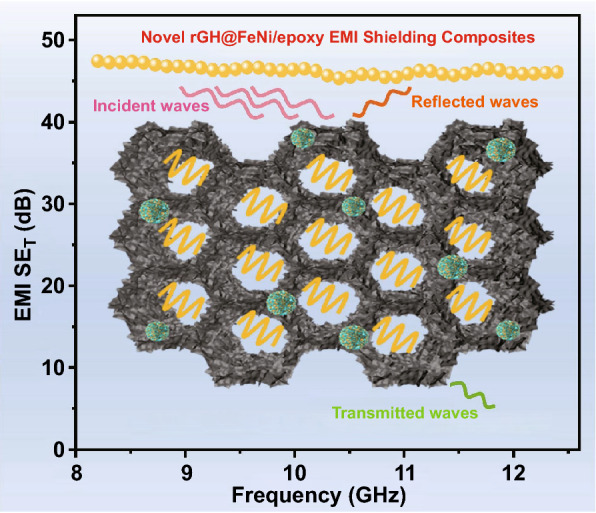- Record: found
- Abstract: found
- Article: found
High-Efficiency Electromagnetic Interference Shielding of rGO@FeNi/Epoxy Composites with Regular Honeycomb Structures

Read this article at
Highlights
-
The rGH@FeNi/epoxy electromagnetic interference (EMI) shielding composites with regular 3D honeycomb structures were prepared by sacrificial template, freeze-drying and vacuum-assisted impregnation of epoxy resin.
-
The construction of 3D honeycomb structure and electromagnetic synergistic effect significantly increase the EMI shielding effectiveness and reduce the secondary contamination.
-
The rGH@FeNi/epoxy composites possess excellent thermal stability and mechanical properties.
Abstract
With the rapid development of fifth-generation mobile communication technology and wearable electronic devices, electromagnetic interference and radiation pollution caused by electromagnetic waves have attracted worldwide attention. Therefore, the design and development of highly efficient EMI shielding materials are of great importance. In this work, the three-dimensional graphene oxide (GO) with regular honeycomb structure (GH) is firstly constructed by sacrificial template and freeze-drying methods. Then, the amino functionalized FeNi alloy particles ( f-FeNi) are loaded on the GH skeleton followed by in-situ reduction to prepare rGH@FeNi aerogel. Finally, the rGH@FeNi/epoxy EMI shielding composites with regular honeycomb structure is obtained by vacuum-assisted impregnation of epoxy resin. Benefitting from the construction of regular honeycomb structure and electromagnetic synergistic effect, the rGH@FeNi/epoxy composites with a low rGH@FeNi mass fraction of 2.1 wt% (rGH and f-FeNi are 1.2 and 0.9 wt%, respectively) exhibit a high EMI shielding effectiveness (EMI SE) of 46 dB, which is 5.8 times of that (8 dB) for rGO/FeNi/epoxy composites with the same rGO/FeNi mass fraction. At the same time, the rGH@FeNi/epoxy composites also possess excellent thermal stability (heat-resistance index and temperature at the maximum decomposition rate are 179.1 and 389.0 °C respectively) and mechanical properties (storage modulus is 8296.2 MPa).

Related collections
Most cited references61
- Record: found
- Abstract: not found
- Article: not found
2D metal carbides and nitrides (MXenes) for energy storage
- Record: found
- Abstract: found
- Article: not found
Three-dimensional flexible and conductive interconnected graphene networks grown by chemical vapour deposition.
- Record: found
- Abstract: not found
- Article: not found